This continues from here.
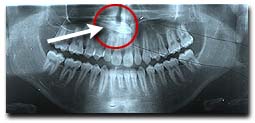
- Ectopic canine @ stringertorthodontics
Un-erupted tooth
Permanent teeth may submerge inside the jaw bone or gums for a few reasons.
Causes
- Impaction due to insufficient space
- Missing genetically
- Ectopic tooth – tooth is not at its original eruption site, it has been displaced to somewhere else. This usually happens to permanent canine.
- Ankylosis of baby teeth ( baby teeth’s roots fused to jaw bone causing it to retain and not falling off accordingly)
Test and Diagnosis
- Radiograph (X rays) such as OPG (Orthopantomogram) or occlusal films would be able to pick up the whereabouts of un-erupted teeth and determine its cause of uneruption.
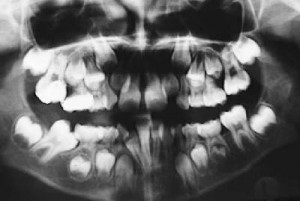
OPG @ home.flash.net
Treatment
- Orthodontic treatment (braces) to realign the teeth
- Restore genetically missing teeth with denture, fixed bridges or implants
- A ‘misplaced’ un-erupted tooth is usually surgically removed to prevent cyst formation and infection.
- Ankylosed baby tooth would not grow with jaw so it would look submerged in time compared to its adjacent teeth. Sometimes it is advisable to extract or surgically removed it and restore it later with methods as mentioned above.
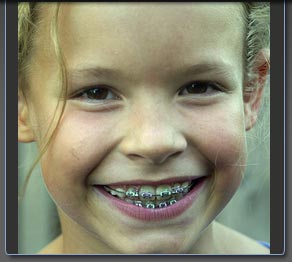
orthodontic treatment for children @ aligndoc.com
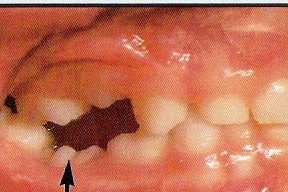
- Submerged baby tooth @ orthodontics.org
Prevention
- Keep track of normal tooth eruption in children.
- Compare among peers and siblings of children for sequence of tooth eruption
- Routine dental check up ( 3 months or 6 months interval )
Crooked teeth
This is a problem with the alignment of teeth. Usually happens when space is insufficient for tooth eruption. The only way to treat it is orthodontic treatment or braces. It is often treated as early as possible as children’s teeth move faster than adult. In some cases, extraction of some sound teeth is inevitable to make space for realignment. Your child could see a dentist or orthodontist who specializes in this field.
Tetracycline stained teeth
It is characterized by certain yellowish and brownish strips or discoloration on all the surfaces of teeth which is not removable.
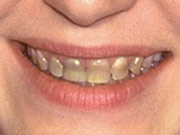
- Tetracycline staining @ cityviewdental.ca
Cause
Mother or the child ingests tetracycline (a type of antibiotic) while the teeth are forming either in the womb of mother or when the child was young. It is susceptible to decay therefore strict oral hygiene is important.
Treatment
- To do crowns or veneers to mask the esthetically displeasing color of teeth when the child reaches 18 years of age.
- Frequent follow ups with the dentist to help maintain their vitality.
Prevention
Avoid taking tetracycline throughout pregnancy and while the child is growing from 1-8 years of age.
Dental fluorosis
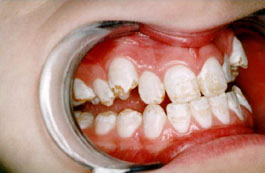
- Severe fluorosis @ fluoridealert.org
It is seen as white spots, streaks or flecks on the surface of the teeth. Some severe cases may even have yellowish and brownish discoloration.
Causes
This is common when a child is receiving high amount of fluoride through drinking fluoridated water or accidental ingestion of toothpaste. Drinking fluoridated water with recommended low levels of fluoride would not cause this.
Treatment
- No treatment is required if the staining is not severe.
- Crowns or veneers are advisable if the discoloration is severe.
Precaution
Fluorosis made the tooth surface both weaker and stronger in certain cases. For weaker cases stringent oral hygiene is essential to prevent tooth decay.
Conclusion
If we manage to incorporate dental health into our children’s life, we help bring them a good smile and a better future. So start now and never regret later.
If you wish to read the part I, click here.